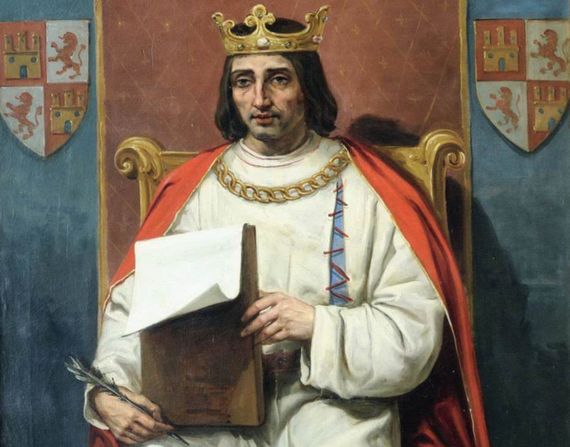If the expression “the dark ages” could refer to a specific time, it could well be 1221. In that year, the fifth crusade ended, a useless war that left things exactly as they were before it began. Meanwhile, Genghis Khan was consolidating his Mongol empire, leaving behind immense massacres with millions of corpses. And yet, in those dark times, there was born a rare luminary would go on to facilitate what three centuries later would become the Copernican revolution: King Alfonso X of Castile, called The Wise.
It’s not that King Alfonso (23 November 1221 – 4 April 1284) wasn’t dedicated to the usual pastimes of the monarchs of his time, that is to say, conquering, pillaging and embroiling himself in battles over succession and conspiracies of power, which would lead him to order the execution of his own brother Fadrique. His reign, from 1252 until his death, was embedded in the middle of the Reconquista against the Muslims, in which he had ample opportunity to put his mark on history with his own share of bloody massacres.

However, Alfonso had an influence that was unusual in his epoch: his mother, the German Beatrice of Swabia, an educated woman raised in the court of her cousin Frederick II of Hohenstaufen, an enthusiastic promoter of the arts and sciences, and founder of the University of Naples. Beatriz conveyed her love for culture to her children, as a result of which Alfonso gathered in his court a cosmopolitan amalgam of Christian, Jewish and Muslim intellectuals. By reorienting the work of the School of Translators of Toledo towards translating the works into Castilian instead of Latin, he encouraged the use of this then-vulgar language, laying the foundations of the Spanish language.
Among the works translated by those scholars were numerous scientific and medical texts of Jewish or Arab origin. And among these, one of the most outstanding contributions of the monarch was undoubtedly the Alfonsine Tables, a record of astronomical data from the observation of the skies above Toledo. The work updated the Toledo Tables produced in the 11th century by the Arab-Toledo astronomer al-Zarqālī and others. Based on the geocentric system of Ptolemy, the new tables published under Alfonso’s orders were drawn up between 1263 and 1272 under the direction of the Jewish astronomers Yehuda ben Moshe and Isaac ibn Sid.
A link between Ptolemy and Copernicus
Unfortunately, the original manuscript tables in Spanish have not been preserved. In fact, the work disappeared for half a century, until in 1321 a Latin version turned up in Paris, copies of which began to circulate around Europe. Thus, the Alfonsine Tables became for centuries the most popular instrument in the West for calculating the ephemerides or positions of the stars, also used by astrologers to formulate their predictions. The first printed version appeared in 1483 in Venice. The second edition was published in 1492, and one of those copies was acquired by a young student at the University of Krakow (Poland) named Nicolaus Copernicus.

Copernicus had his copy bound with leather covers and added 16 blank sheets for his annotations. Thus began a career that half a century later, shortly before the death of the Polish astronomer in 1543, culminated in the publication of De revolutionibus orbium coelestium, a premonitory title of the revolution that he sparked: that of the heliocentric system that overthrew Ptolemy’s geocentrism.
Alfonso’s tables were by no means the only ones that Copernicus used, and it has been questioned whether he came to rely on them extensively. Moreover, it has even been suggested that the Parisian tables, which today pass for being Alfonsine, perhaps did not even come from these but were a completely independent production. At the end of the day, however, it was the dark ages, and many of those details will probably be forever enveloped in darkness. But one thing that’s unquestionable is that Alfonso X the Wise has gone down in history as the link between Ptolemy and Copernicus, in a chain that lasted until what we now know as the beginning of the scientific revolution.
Comments on this publication